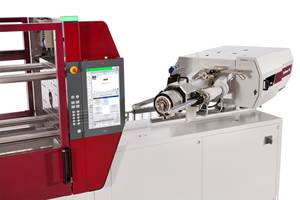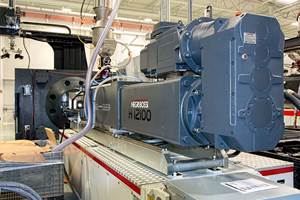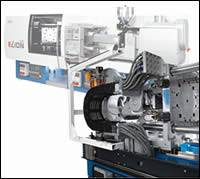The Next Generation of Multi-Component Molding
Multi-shot and coinjection molding techniques are staking out new territory. Mach ines are getting larger and are combining more materials or colors in more sophisticated and imaginative ways.
Multi-component injection molding has had a lot of "buzz" in recent years, stimulated by popularity of multi-color and soft-touch overmolded products for consumer, automotive, packaging, and other markets. The technology continues to evolve in new directions: Recent developments include trends toward larger parts and larger presses, machines with four to six barrels, thermoplastic/thermoset combinations, sophisticated multi-face tooling that allows for in-mold finishing and assembly, combinations of multiple materials with gas or water assist, and novel uses for coinjection machinery that extend well beyond burying low-cost scrap material inside a part.
For all the talk about multi-color and multi-material molding, machine and mold builders say demand in North America is still only 2% to 10% of their sales. That lags significantly behind activity in Europe. For example, over 20% of Ferromatik Milacron's sales in Germany is multi-component presses, according to Bob Strickley, director of marketing for injection molding in North America. He says U.S. interest has risen above 15% of Milacron's injection machine quoting activity.
The SPI Machinery Div. reports a 38% increase in multi-component machine sales in 2004 to 120 from 92 in 2003, not counting add-on units. MGS Mfg. Group, a builder of add-on injection units as well as molds, says 25% to 40% of the tools it makes are for multi-component applications.
"We have seen quite a lot of inquiries here from customers looking for ways to differentiate their molding capabilities and their clients' products," says Larry Doyle, North American marketing director and international product manager for Demag Plastics Group. Many multi-shot or coinjection presses are customized, so entering the multi-component field can be expensive, but the increased versatility it offers is starting to win molders over.
For one thing, injection molders are realizing how much they can save by producing a finished part in the mold without the use of downstream equipment that takes up plant floor space and is expensive to buy, operate, and maintain. Assembly costs may be reduced by up to 20% while total manufacturing cycle time may be trimmed 20% due to less handling of the part. Capital investment for a project may be trimmed up to 25% by using one machine and mold instead of two.
"Not only are we seeing continued growth of high-volume parts in multi-component applications, but now lower volume parts are also benefiting from this technology," says Ron Cisliek, v.p. of Braunform Inc., new U.S. subsidiary of German moldmaker Braun Formenbau GmbH. "There is a general trend toward consolidation of parts, so people want new ways to add features like a gasket or seal without secondary operations outside the mold," says Cisliek. Cisliek says about 65% of the 100 molds built by Braun each year go into multi-material applications. The company also supplies rotary tables and other tooling technologies for multi-component molding.
Bigger presses go 'multi'
One of the hottest new trends in multi-component molding is toward high-tonnage press applications. "Seven or eight years ago, 90% of multi-component applications were for parts that were below 50 tons, but the market is growing and now about 70% are below 500 tons," says Joachim Kragl, Engel's manager of processing technology. Presses of up to 1500 tons with two to four injection units are becoming more common, say sources at Engel and Milacron.
Many of these ma chines are going into automotive applications. Demag customized a 2200-ton, two-platen Caliber press with a second injection unit to make automotive trim. Ube Industries built a multi-component machine of 4000 tons that molds auto-interior, under-hood, and HVAC parts. Negri Bossi is building a 6600-ton two-shot machine for making crates and is also designing a new rotary table featuring larger hydraulic motors for faster operation, says Liam Burns, general manager.
JSW builds standard twin-barrel hydraulic machines in its J-EII2M series up to 935 tons. Meiki has built multi-shot machines with vertical clamps up to 1760 tons and horizontal clamps up to 1980 tons.
An SPE 2004 Innovation Award went to Visteon Automotive Systems, Saline, Mich., and Husky Injection Molding Systems for a two-color polypropylene instrument panel for the 2005 Ford Mustang. What made this part unusual was the "simultaneous-shot" injection process that used sequential valve gating to fill both colors in one cycle, eliminating the need for a rotary table or other two-shot technique. Capital investment for the system was reduced to 70% of the cost of a standard two-shot press, and tooling cost was trimmed by about 55%. Cycle time reportedly was similar to that for molding a standard IP. This was said to be the first use of simultaneous-shot injection in a large part.
Last year, Husky also rolled out its new Quadlock Tandem Index (QTI) press concept that combines three separate Husky processes into a machine designed for large, multi-shot automotive applications. The first machine built is a 3150-tonner. The system integrates Husky's tandem stack-mold concept with its Index rotating center platen on a Quadloc two-platen press. A part is molded in one mold face, then the rotating turret turns on a horizontal axis to deliver the shot to the second injection half. "The system can accommodate conventional tools so a special mold does not need to be built," says Ali Mortazavi, automotive marketing manager at Husky. One especially unusual feature of this machine is the second injection unit, which is alongside the machine parallel to the machine axis. It is mounted on a rail so that it travels back and forth with the moving platen, to which it is attached.
Auto glazing beckons
One of the most intriguing new applications for large multi-component machines is the nascent field of polycarbonate automotive glazing. Battenfeld, Engel, and Krauss-Maffei have been working for the last few years to develop technology for molding large, stress-free auto side and rear windows and sunroofs with integrally molded sealing or framing components.
Krauss-Maffei has sold a 3200-ton Revolution two-platen press to mold glazing for Mercedes-Benz and the Smart car in Europe. The unit features two injection units on the moving platen and a third injector on the stationary side. The two injection units mold clear PC in two cavities, then the center platen rotates and a dark-colored PC is injected to make the frame, says Peter Lipp, U.S. national sales manager. The unit is in commercial production at Freeglass GmbH in Schwaikheim, Germany.
Engel molded a two-component PC sunroof with an integral support frame in clear and black PC on a 1500-ton Duo Combi CS two-platen unit with a rotating center stack mold at the K 2004 show.
The latest from Battenfeld is a new rotary-platen technology for glazing. Its Wendi platen concept is offered on three models of HM series of large two-platen machines—880 and 1630 tons and a new 3000-tonner. According to Tom Betts, Midwest regional sales manager, the new center rotating stack is a further development of the company's IMPmore (In-Mold Pressing) injection-compression process for stress-free glazing. A special tilting mold pools the main (11-lb) shot of PC in the upper section of the tool in a low-pressure injection step, then changes the angle of one tool half as the mold slowly closes in the compression step. In place of the initial single-face mold (demonstrated at NPE 2003 and K 2004), the new Wendi platen rotates 180° to a second position where a frame is molded onto the window. Injection-compression is used on the second shot, too, so that stresses are not introduced. The opposed injection units are mounted at each end of the machine.
A 1630-ton Wendi press is being delivered to a molder serving a large European automotive maker, where it will produce a 1.4-sq-m part for a 2005 vehicle. "The Wendi platen targets auto glazing but you can do other applications such as door panels in two colors, vertical panels, and more," says Betts. The system allows for sealing lips or fastening elements of different colors or materials to be integrated in large multi-component parts. The rotating platen also uses less floor space than a rotary table, which would greatly increase tool and machine size, Betts notes.
Coinjection breaks out
Another area of large-part progress for multi-component molding is in coinjection. This process typically uses a special nozzle to bring two or more materials together to create layered or sandwich structures. Custom molder Bemis Manufacturing, Sheboygan Falls, Wis., has the world's largest coinjection press, a Milacron 6600-ton Maxima two-platen press, which it is using to mold what are said to be the largest parts ever made by coinjection. The first job on that press was the John Deere 8000 series tractor hood weighing 58 lb. The part consists of the same glass-filled PBT shot from both barrels. Bemis took advantage of a little-known effect of coinjection: Even when molding a single material, the process creates a skin/core structure that can significantly increase the impact strength of the part.
Bemis later used the same mammoth press to mold the 34-lb John Deere 7000 series tractor hood of PC/PBT alloy with a center layer of reground auto bumpers (from another molder) made of the same material. Two 22-lb side panels of the same materials were also produced in a two-cavity mold. Bemis incorporated 34% low-cost scrap in these parts and is now working to increase that level to 55%, says Gary Vande Berg, director of engineering for injection molding.
Bemis has 28 Milacron multi-barrel machines at its plant, ranging from 500 to 6600 tons. Multi-component molding makes up about 75% of its business, says Vande Berg. The company just installed another huge coinjection press, the second-largest ever built by Milacron, a Maxima 3900 (4400 tons), with two 854-oz electric injection units.
As one of the relatively few practitioners of coinjection technology, Bemis has come up with many novel uses for machines that are commonly viewed as highly specialized. For example, Bemis has coinjected a steering wheel with a PP foam core and glass/PP skin. After the first shot, the tool rotates so that a third barrel can overmold part of the wheel with a soft-touch material.
Vande Berg says coinjected melt streams can even be directed into separate cavities of a family mold. An example is simultaneously molding two polycarbonate headlight lenses for a tractor and four ABS lamp reflectors in a single 725-ton press. An alternative is sequential filling of separate cavities of the same mold with different materials. For example, mold one part with barrel A, and while that part is in pack and hold, mold the second part with barrel B. The advantage is that much less clamp tonnage is required.
Bemis and Milacron together have come up with another new coinjection concept whereby the core material intentionally breaks through the skin of the part in a controlled and repeatable fashion. This "controlled breakout" technique produces parts where one material is partially encapsulated by the other. Rigid and flexible combinations are one likely use. For example, automotive mudflaps could have a primarily rigid structure at the end that is mounted to the vehicle, while the other end of the part is an unencapsulated flexible material that encounters road dirt and debris.
Not all coinjection requires multiple barrels. Spirex manufactures a special two-stage screw that plasticates two materials separately. Material fed into the first stage is melted and then bypasses the second stage (where another material is plasticated) via a channel in the center of the screw. This Twinshot screw is retrofittable on standard machines. It has been offered on presses from Demag, Negri Bossi, and Toshiba. Typical uses have been to bury a scrap layer such as painted or chrome-plated automotive regrind, or else to minimize use of expensive colorants or uv stabilizers by restricting them to the surface layers. Spirex says at least 42 Twinshot units have been sold, the largest being a 637-oz model on a 2000-ton press molding a bathroom component from foamed ABS encapsulated with acrylic.
Meanwhile, Meiki is marketing a new Master Mold Plate (MMP) concept, licensed from Kobe Steel, that provides an economical way to convert standard machines to coinjection. In place of a special multi-channel nozzle, the MMP is a backplate in which two melt streams join just behind the mold.
Lots of shots
"Most multi-component molding in North America is two- or three-component," says Engel's Kragl. But there is activity from firms such as Arburg, Demag, Engel, and Milacron in designing presses with four, five, and six injectors.
Arburg, a pioneer of multi-component molding with its development of a rotary mold insert in the early 1960s for typewriter and telephone keys, recently launched a five-barrel system for molding toothbrushes. Developed with its tooling partner Zahoransky of Freiberg, Germany, the 275-ton Allrounder 630S model has a horizontal main injector (166-g shot size) for the PP toothbrush body, plus four vertical injection units, each with 28-g shot size, for overmolding different colors of a soft TPV. The vertical injectors are mounted in a row on a common base plate on top of the fixed platen. The units are powered through a central hydraulic accumulator, so additional pumps, tanks, or control devices were eliminated.
Molding takes place inside a three-station, eight-cavity rotary mold with an electric indexing drive. There are two molding stations and a third, "open" station for robotic parts removal.
The advantage of such a system is its flexibility, says Arburg president Friedrich Kanz. The system can simultaneously inject four colors—each one going into two of the eight cavities. Or, just one or two colors could be injected, and then it would be possible to shut off those colors and switch immediately to different colors without requiring downtime for cleaning the injection unit and hopper.
Kanz says Arburg is evaluating development of a six-component press, where the additional unit is positioned at a 45° angle behind the fixed platen.
Negri Bossi also has built a six-barreled machine to make toothbrushes of PP overmolded with TPV in four different colors simultaneously. This system uses moving cores instead of a rotary mold. Four small vertical injectors are mounted in a row atop the fixed platen.
Netstal has built Synergy machines for up to six colors, with three horizontal and three vertical barrels. Krauss-Maffei says its MC two-platen units are designed for up to seven injection units. Models of 1300 to 2000 tons are molding auto taillights with up to six injectors. Three are mounted horizontally and three vertically.
On the cutting edge
Some of the most complex multi-component applications today combine multiple materials with in-mold decorating or assembly or technologies such as gas or water assist.
Rotating center stacks can provide up to four mold faces for multi-injection and other operations. For example, Gram Technology of Denmark, which recently established a U.S. operation, is developing a four-color molding project with in-mold assembly. This unusual concept uses six of Gram's multi-cavity Spin Stacks between the moving and stationary platens. The standard injection unit delivers one melt to the first two Spin Stacks. The next two Spin Stacks are fed from above by vertical injectors, one for each pair of stacks. The last pair of stacks is also fed by the fourth injector in the horizontal "L" position. After the first color is shot, the part is transferred from one Spin Stack to another, where it is overmolded with the second color. Then it is transferred to the third stack, where it is overmolded on both sides with two more colors.
A second developmental project for Gram involves in-mold assembly of two clear polycarbonate shells with a silicone diaphragm. The two shells are molded in two Spin Stacks in one machine, and the diaphragm is transferred from a second machine and inserted in one shell. In one position of the rotating stacks, a PC shell's mating surface is heated so that the two shells weld together when joined by opposing stacks.
Juno Inc., a custom molder in Anoka, Minn., uses Gram Technology Spin Stack molds to achieve faster cycles and produce in-mold assemblies, says Jim Grossman, multi-component engineering manager. "On some parts, we're injecting the same material in two shots with a steel change between shots. This layering two-shot approach can produce complex geometries that are unattainable with conventional molding methods," Grossman says.
Sandretto demonstrated three-component molding together with in-mold labeling at K 2004. At the same show, Ferromatik Milacron ran a new multi-component system with in-mold labeling and in-mold assembly at K 2004. It used a new Twin Cube system with two rotating stacks built by Foboha in Germany. Each of the four-faced turning cubes had 16 cavities per side. It molded two small PP parts in different colors, snapped them together and applied an adhesive label, all in a 6.2-sec cycle on a 275-ton K-Tec machine.
Rotating center-stack tooling is undeniably more expensive, but it could pay for itself in job runs as small as 50,000 parts a year, says Gram Technology's v.p. of sales and marketing, Hermann Plank. A large automotive part with molded-in snap-in or clip-on inserts and a flexible gasket could be very difficult to mold normally and might require an expensive fixture for secondary operations, Plank explains. "But with our Spin Stack technology, costing $200,000 up front for the tool, the molder could save $500,000 on automation and 75% on floor space."
At NPE 2003, HPM launched its first units with a rotating center platen for multi-component and insert molding. The Freedom Rotator two-platen series started with an 1100-ton size.
Combinations of multi-component molding and water assist were demonstrated at K 2004 by Krauss-Maffei in cooperation with material supplier A. Schulman and water-injection specialist PME Fluidtec of Germany (represented here by K-M and Husky). A diesel engine cooling pipe was molded with a two-layer wall of PP and glass-filled nylon and cored out with water in a 48-sec cycle.
Engel sources also see opportunities for multi-component molding to be combined with gas or water assist. Engel built a system that molds a nylon handle that is hollowed and cooled with water injection. Then the part is transferred by robot to another cavity where a TPE soft grip is overmolded. Engel has also demonstrated molding an automotive fuel-system part with a glass-filled nylon skin and barrier nylon core that is hollowed with water assist. Another Engel demonstration project produced a TPO part with a PP core made lighter with the Mucell microcellular foam process from Trexel.
Overmolding of thermoplastics with thermosets—usually a liquid silicone rubber (LSR) seal or gasket—has attracted growing interest as one extreme of multi-material molding. Arburg and Engel demonstrated nylon/LSR molding at K 2004. Engel has supplied equipment for molding medical-grade PC with LSR. Engel also developed a three-station, off-center rotary-table system for molding PBT/LSR strainers in an 85-ton tiebarless press. The third station (and optional fourth) could be used for post-cooling, plasma treating for adhesion, insert loading, or parts removal.
Incidentally, Boy Machines demonstrated two-color molding of all-LSR baby-bottle nipples at the last NPE.
In a world first, Krauss-Maffei combined injection molding and polyurethane RIM in one mold and machine at K 2004. A CX two-platen press with a shuttle mold overmolded a nylon auto seatbelt cover with liquid PUR by means of a mixhead mounted on the moving platen. Another K-M system at the show overmolded thermoplastic golf-ball cores with a PUR skin. The cores had been injection molded in a separate machine.
In the pursuit of higher speed and precision, as well as energy savings, more and more suppliers are coming out with all-electric multi-component systems. Examples to date include Arburg, MHI, Milacron (Powerline, Fanuc, and Elektra models), Nissei, Sumitomo, Toshiba, and Toyo. Sumitomo notes that its 130-ton SED-CI machine has a separate direct-drive electric motor for the rotary table, which can index in 0.97 sec. And Milacron's Strickley says that firm has developed proprietary MIMC (Multi Independent Motion/Multi-Component) technology for its electric machines that coordinates and optimizes the sequence of clamp and multi-injector functions to minimize cycle time. Though highly application-specific, MIMC reportedly has trimmed cycles by up to 25%.
Add-on's advantage
An increasingly popular option is portable or bolt-on secondary injection units that can convert a standard press for multi-component operation. Small add-on injectors are often mounted on the fixed or moving platen. Processors gain relatively low-cost entry to multi-component molding by converting an existing machine, which can be switched back to standard molding later on.
"If a customer doesn't have large volume but is looking to add some functionality or aesthetic improvement to a part, this is a way to get to know multi-component technology," says Betts of Battenfeld, which recently introduced a new add-on unit.
Demag says its Multi-Plug add-on injectors are designed primarily for molders who want to try out multi-injection molding or want the flexibility an add-on offers. "A molder new to multi-molding or one who has several multi-component jobs would be able to move the secondary injector from one press to another," says Demag's Doyle. He cites a case in which the firm's Multi-Plug injector was tied to a 950-ton Caliber machine for a low-volume job to make taillight lenses.
MGS, Milacron, Mir, Toshiba, and Toyo (represented by Maruka) offer electric add-on injectors. Although some are designed specifically to run with the company's all-electric presses, others like MGS's new model can be used on any type of electric or hydraulic press.
MGS says it has sold more than 200 add-on units and offers units that deliver up to 96-oz shots. It has sold six of its new electric Universal MultiShot units (0.5 to 2 oz). The company also rolled out a new vertically mounted unit for LSR molding.
Other suppliers of add-on injection units include Cannon Group's Windsor Kunststofftechnologie, Krauss-Maffei, Meiki, Milacron, and Nissei. (Windsor and sister company Sandretto are newly represented in North America by HPM.)
Related Content
Fakuma 2023: More Details on New Machine Line
Wittmann Battenfeld has released more details on the new EcoPower B8X debuting at Fakuma (October 17-21; Friedrichshafen, Germany), which it previously announced.
Read MoreAbsolute Haitian Brings Next Generation of Presses to Orlando
Absolute Haitian says Generation 5 of the servo-hydraulic Haitian and electric Zhafir machines lines emphasize efficiency, performance and intelligence.
Read MoreWord Games: What’s a ‘Hybrid’?
Any molder will tell you there’s a difference in working with electric vs. hydraulic drives. Servohydraulic is still hydraulic; a hybrid machine is something different. Imprecise use of terms causes needless confusion.
Read MoreFakuma 2023: Wittmann Battenfeld Expands All-Electric Line, Direct-Current Capabilities
Wittmann Battenfeld will introduce the new EcoPower B8X injection molding machine line and show direct current as an energy source for a concept machine that will power its own robot.
Read MoreRead Next
K 2004 Wrap-Up on Injection Molding: Spotlight on Electric And Multi-Component Machines
Molders were treated to a trove of injection machinery introductions geared toward applications from micro-molding to packaging to large parts.
Read MoreTwo-Material Automotive Part Is Cored Out with Water
A three-stage injection process involving nylon, polypropylene, and water assist was demonstrated at the recent K 2004 show in Dusseldorf, Germany.
Read MoreStack Molds Take on New Tasks
Conventional stack-mold designs are well known for their ability to outrace the productivity of conventional single-face molds.
Read More


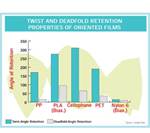

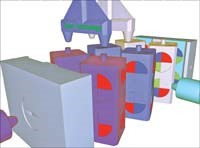
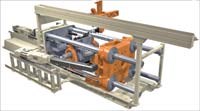
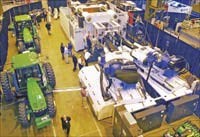
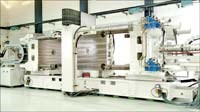








.png;maxWidth=300;quality=90)










